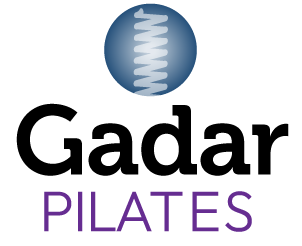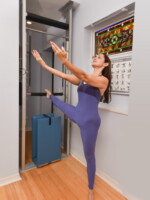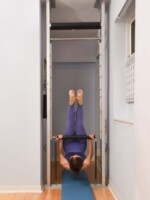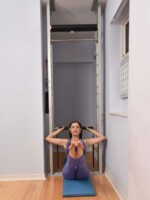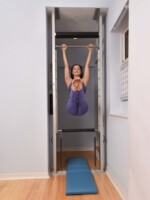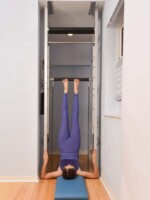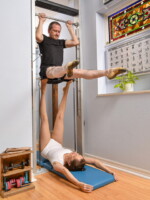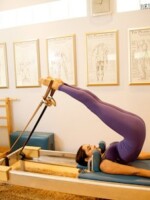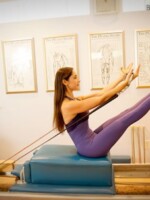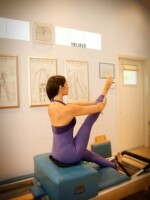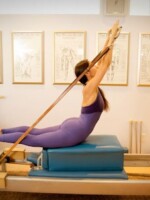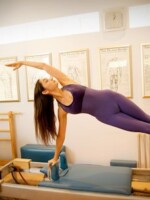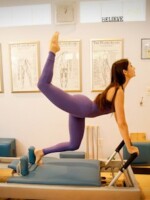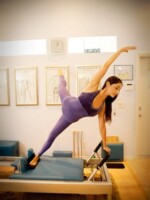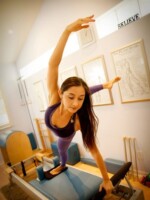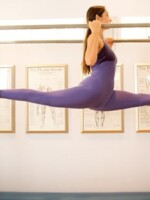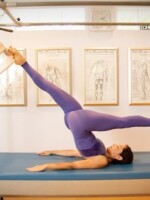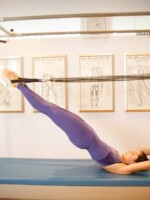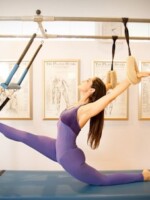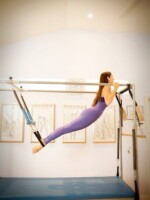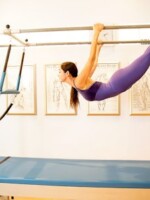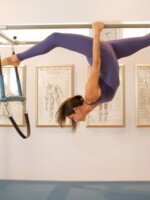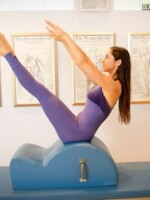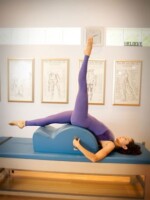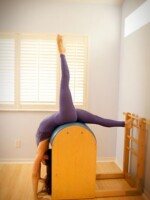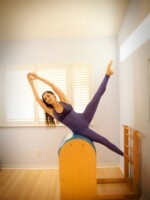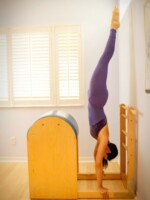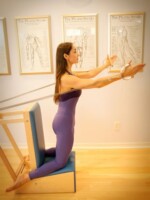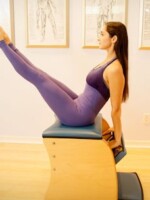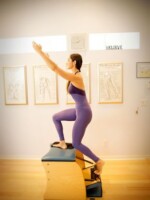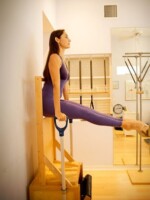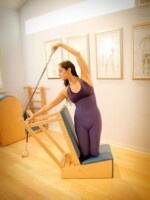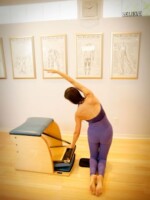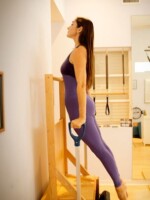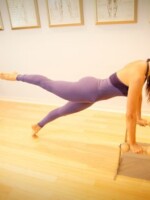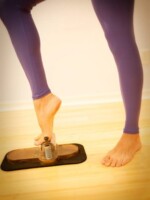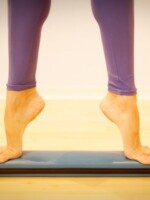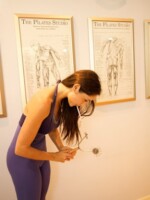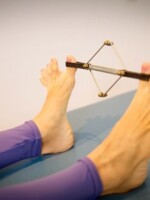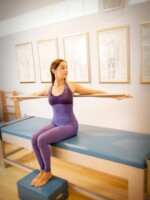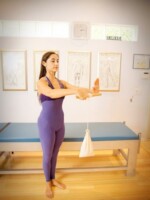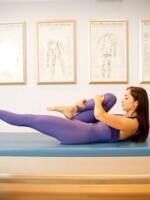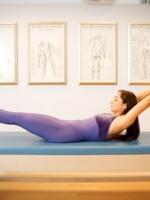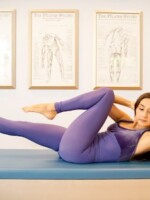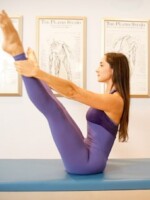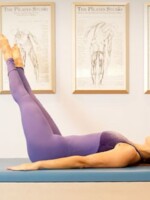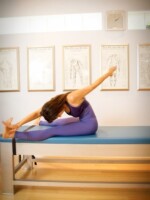Guillotine Apparatus
Gadar Pilates is proud to be the first (and only) Pilates studio in Sarasota, Florida equipped with a Guillotine apparatus! And the Guillotine at Gadar Pilates takes the exercise apparatus back to its historical roots because it is installed in a doorway just like Joseph Pilates’ home model which was called the Gym in a Doorway. The Guillotine is where experienced students take their work to the next level. With two springs attached to the movable bar from above or below, the biggest challenge is keeping the bar level as the feet or hands move it up and down. The Guillotine is also a great place for acrobatic students to work on skills performed hanging from the horizontal gym bar. The Pilates Guillotine gets its name from a Pilates exercise which is performed lying face up on the floor mat with the movable Guillotine Bar overhead. For the ideal placement, the student positions her throat directly beneath the bar overhead before putting her feet on the bar.
Reformer Apparatus
The Reformer apparatus is the fundamental Pilates apparatus. Along with the Matwork, it forms the heart and soul of the Pilates system. All Reformer workouts start out with the student lying down with the head supported in a headrest and feet supported on a foot bar, thus “cradling” the body. Although the carriage just slides back and forth, postures on the Reformer vary from lying down, sitting, kneeling and standing. Using up to four springs for resistance, students are constantly lengthening and strengthening their muscles while exercising control over the springs.
Cadillac Apparatus
Joseph Pilates believed the bed was the most important piece of furniture in the home. He created many types of beds including a posture correcting and rejuvenating bed that could be transformed into a gymnasium by attaching springs and bars to the bedposts. This was a very important invention because it allowed students with very weak muscles the opportunity to exercise while lying down. As time passed, Joseph Pilates integrated additional parts to the apparatus. The Cadillac apparatus as we know it today was named at a time when its namesake automobile was the prestige car in America. The current version consists of a padded platform with a cage-like frame above it, to which various bars and straps are attached by springs. The Cadillac can be used in numerous ways, ranging from rehabilitative exercises to acrobatic-like movements.
Barrels
There are three Pilates barrels: the Small Barrel, the Spine Corrector, and the Ladder Barrel. It is said that beer kegs inspired Joseph Pilates when creating the original barrel (the steel keg hoop inspired the Magic Circle). The Small Barrel is for basic exercises and smaller people. The Spine Corrector works on a deeper stretch because of the height of its barrel. The Ladder Barrel helps to support placement and extension of the legs while standing. The barrels are designed to open the chest, correct the spinal alignment and increase flexibility in the hips.
Chairs
There are three Pilates chairs: the Arm Chair, High Chair, and Wunda Chair. The Arm Chair’s lighter springs make it safe for older students and pregnant students to work the upper body, while the angle of the seat of the Arm Chair makes it perfect for stretching students with tight lower backs. The High Chair, with its back support and handles, supports the spine during seated exercises and properly aligns the legs during standing exercises that work on strength and stability. The Wunda Chair is considered the original home gym and doubles as a piece of furniture. Inspired by the training of Chinese acrobats, Joseph Pilates took their platform and added a step with two springs that can be arranged in nine different ways, creating the ultimate workout challenge.
Accessories
Joseph Pilates created brilliant innovations to address the specific needs of his clients. It has been said that the Ped-O-Pul was designed for a famous opera singer. Its design mirrors the spine and enhances posture, strength, and stability. According to Joseph Pilates, proper alignment begins with strong feet, so he created the 2×4, Toe Exerciser, and Foot Corrector to help students strengthen their feet and work on reflexology. The Long Pole is an accessory used for stretching the sides of the body, opening the shoulders, and “wringing out the lungs.” The Sand Bag works to build strength in the forearms, wrists, hands, and fingers. The Push-Up Devices were adapted from gymnastics (similar to the even parallel bars) to increase range in push-ups while eliminating pressure in the wrists. The Breathing Device was designed to increase breath and circulation in the body while building stamina. Although not pictured, Gadar Pilates is also equipped with the foldable Pilates Mat with Dowels, Swedish Bars, the traditional and mini Magic Circles, Neck Tensometer, Finger Corrector, Joe’s Posture and Poise apparatus, multiple vintage hand weights, and a reproduction of Joseph Pilates’ Archival Weighted Shoes with authentic vintage shoe plates made from weighted metal.
Matwork
Joseph Pilates drew upon other methods of exercise (swimming, boxing, skiing, dancing, and gymnastics) and he took inspiration from nature (the movement of animals and children) to create the Matwork exercises. He considered the Matwork exercises the routine that required the height of control. He developed the equipment with the intention to help his students do the Matwork well. With no headrest, foot bar, pedal, springs, handles, straps, or bars, the Matwork requires complete coordination of mind and body. It was with a clear vision that Joseph Pilates united the exercises done on the mat and on each apparatus to create the comprehensive system that we called the Pilates Method.
